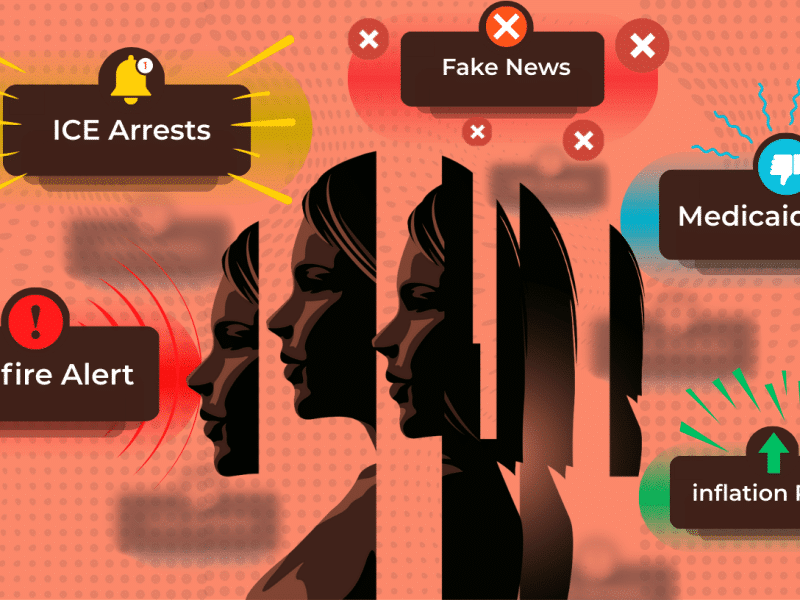Sharp Rise in STDs for Latinas Means Change is Needed
As the largest community of people of color in the United States, the Latino population faces additional socio-economic challenges unique to them.

This reporting was produced in partnership with the Northeast Valley Health Corporation.
As the largest community of people of color in the United States, the Latino population faces additional socio-economic challenges unique to them. Limited access to healthcare, education, and employment opportunities are only a few obstacles to better life outcomes. The lack of access to healthcare, specifically, is contributing to the shocking increase in STD rates among Latinas.
The often overlooked issue of STDs and their disproportionate impact on the Latino population is a silent threat looming over men and women of all ages, but the numbers are rising among Latinas and it’s urgent to take action. This increase in Latina STDs isn’t only because of a lack of sex education and limited healthcare access; it’s also due to how stigmatized STDs are within Latino culture, where women are often less likely to discuss STDs with family and intimate partners.
Latinas, particularly Latina immigrants, are highly vulnerable to STDs, with studies showing that they comprise a significant portion of HIV diagnoses. Cultural factors, including traditional gender roles, machismo, marianismo, and a lack of sexual education, contribute to this vulnerability.
The lack of insurance and limited communication with medical providers further exacerbate these challenges. While the issue of STDs is often ignored concerning Latinas, the way it’s shaping and affecting Latina health is beginning to appear more frequently in public discourse.
A Closer Look at the Impact of STDs on Latinas
As is often the case with women within communities of color, Latina women are disproportionately vulnerable to health issues like STDs. Studies show they are 1.7 times more likely to develop high-risk HPV infections compared to other racial/ethnic groups, leading to higher rates of cervical cancer.
HIV and other STDs are also particularly common among Latinas, with HIV affecting Latinas more than other races. Moreover, 91% of new HIV cases are a result of heterosexual contact with an HIV infection rate of 4.9%, which is higher than the 4.5% rate for women overall. They’re also more likely to contract gonorrhea, syphilis, and chlamydia. Misinformation, lack of belief in prevention, negative attitudes toward condoms, and higher rates of unprotected sex contribute to this issue, which has become an epidemic.
Luz Media spoke with Northeast Valley Health Corporation (NEVHC), a community health center based in northeast Los Angeles that offers free and low-cost STD healthcare services, to understand what patients are reporting as barriers to STD testing. When asked what Latina patients say are some reasons they didn’t seek STD testing, Marline Santana, a licensed vocational nurse in the STD Testing and Treatment program, said Latina patients tend to have a “low perceived risk, if married or in a relationship, and they consider there is no need to test for STDs/Sexually Transmitted Infections (STIs). It does not cross their minds that partners may be having sex with other people.”
However, this belief can prevent Latinas from getting early diagnosis and treatment. As an anecdotal example, Angie Gutierrez, STD Program Manager, shared, “One time, we had a patient come in for STD/HIV testing because she found out her husband had been using meth for a few months and had sex with her gay brother, who is also a meth user. Being married for 23 years, she never thought her husband would cheat and put her at risk, which was devastating for her. But she did the right thing by seeking immediate STD testing, and her results came back negative.”
When it comes to STD/STI prevention, Eddy Banuelos, Health Educator, offered this advice for ways in which Latinas can take control of their own sexual health, “[by] talking to your support network about why they should test regularly for HIV/STDs, having open conversations with your medical provider about sexual health, talking to your partners about condom use, not just as a contraceptive method, but also to prevent STD transmission, and taking steps to erase the stigma around STD testing.”
STD Impact on Newborn Babies
Babies are very much affected by Latino parents’ high STD infection rates. The Centers for Disease Control and Prevention released updated data on the overall impact of congenital syphilis–which is when the infection passes from the mom to the baby during pregnancy or during vaginal birth, where the baby can have direct contact with a syphilis sore.
What Latina moms should know is that syphilis infection in their babies can be prevented with early diagnosis and treatment. The CDC found that almost 90% of newborn syphilis cases in 2022 could have been prevented with STD testing and treatment.
Most of these cases are a result of a lack of testing and early detection, which stems from a low sexual health education and leads to improper treatment or no treatment at all. These are some of the reasons why Latino birth parents faced the highest rate of missed prevention opportunities.
Social Media Post by the Houston Chronicle
Social Media Post by the Houston Chronicle
Social Media Post by the Houston Chronicle
Social Media Post by the Houston Chronicle
Social Media Post by the Houston Chronicle
Similarly, the Los Angeles County Annual HIV Surveillance Report revealed that between 2007 and 2022, 46 newborns were diagnosed with HIV, mostly transmitted from their mothers during pregnancy. These findings show how urgently prenatal care, STD/HIV testing, and STD/HIV treatment are needed in all communities.
STD Impact on Teenagers and Young Adults
STDs pose a significant threat to Latina teenagers, young adults, and adults in the U.S., with disproportionately high rates compared to other demographics. Factors such as increased sexual activity, lack of sexual health education, and cultural beliefs contribute to that threat. However, more knowledge about inexpensive or free resources and encouraging conversations about STDs and the importance of STD testing can help turn things around.
In California, half of reported STD cases occur among individuals aged 15 to 24, with Latinos experiencing particularly elevated rates of chlamydia and gonorrhea. Among young Latina women (18-24), syphilis cases are higher compared to whites, especially in the western U.S.
@sexualhealthalliance Talking to your partner about an STD test. 💬💖 #fyp #relationship #std #partner #communicationskills #healthtips
♬ original sound – Sexual Health Alliance
The issue is not only confined to romantic/sexual relationships. Young Latinas don’t often discuss sex or reproductive health with their parents, and they face a lot more cultural barriers than young Latinos. Traditional values regarding virginity and premarital sex create great conflict for them, making them feel like they have to hide, so they don’t openly discuss sexual health or seek related services.
When asked how NEVHC staff helps Latina patients be more comfortable discussing STDs, Osorio said, “Our health educators can have one-on-one conversations to address the stigma surrounding STD testing and discuss how they are transmitted. Moreover, healthcare providers are open to listening to their patients and addressing their concerns about when and how often to test for STDs. We also have bilingual staff, which helps increase the comfort level of Latina patients while having difficult conversations.”
These are not the only efforts the NEVHC makes to support Latinas in the community.
“We try to reflect the populations we serve and have Latina staff, including Registered Nurses, Licensed Vocational Nurses, and Medical Assistants. They can educate and empower our Latina patients to increase their knowledge about sexual health and take charge of their own bodies. Shortly, we will offer support groups in Spanish to discuss different topics around sexual health and how to initiate a conversation with partners to enjoy a healthy sex life,” added Howard Maldonado, Clinic Administrator III.
Exploring the Role of Machismo and Its Impact on Latina Sexual Health
Within the context of sexual health, machismo contributes to the limited use of contraceptives among men and an overall disinterest in sexual education. As such, Latinas are less likely to discuss STD testing with partners, let alone contraception or reproductive health.




